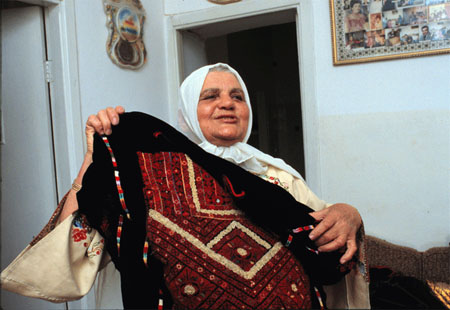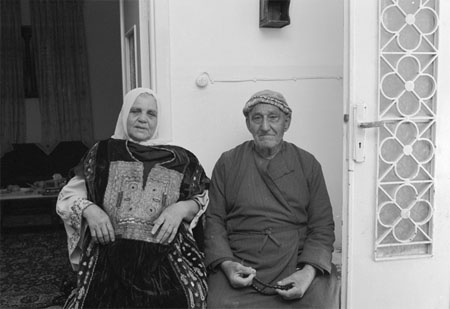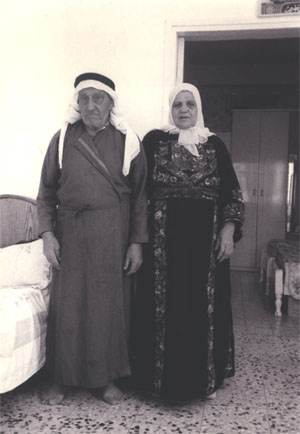
Hajji Aysha introducing Palestinian embroidery, her own dresses. 1999
Photo: Leena Saraste
|
 Hajji Aysha introducing Palestinian embroidery, her own dresses. 1999 Photo: Leena Saraste |
Hajji Aysha Alwayn Aqel, Sheikh Jarrah, East Jerusalem, June 24:
|
 Hajji Aysha Aqel and her husband, East Jerusalem, June 1998 Photo: Leena Saraste |
|
K. takes me to meet a family whose home is threatened with expropriation by the Hebrew University. The land in question is at the top of a hill with a panoramic view of the city. K. says that in Ottoman times this hilltop used to be called Jabal Sharifa or Hayy Urwa Withqa. Now, if you want to get there by 'service' taxi, you ask for the Hebrew University. Its buildings tower above a small plot of land on which stand five or six single-storey Palestinian homes, built after 1948 by refugees from nearby Lifta village on land they owned.
K. is distantly related to the Aqel family. His family also owned land in this area. Most of it was confiscated after 1967. He points to the large America/Israeli-owned hotel below us, built on his family's land. No compensation was ever paid to Palestinian land-owners, once they had been designated under Israeli law as 'absent'. 1 The Hebrew University has in fact offered lump sums to the owners it wants to evict from this land plot. They have refused on the grounds that the land is theirs, and money cannot compensate for the right to live rent-free on land they own. This is a struggle with a long history. The University obtained a large chunk of land belonging to these Lifta families in 1973, to build dormitories. Two years ago a new eviction order was delivered threatening total take-over. The families refused to leave. Their roadside protest demonstrations attracted support from Hebrew University students and faculty. After this Hajji Aysha says, she and her husband have been harassed by Israeli mukhabarat visits. She tells about one of these occasions in her life story. Hajji Aysha is one of those Palestinian women whom you fall in love with at first sight -- warm, strong, energetic, ready to talk, to show...She must be aged around 70, and her husband is over 90, still straight-backed and firm as a post, though a little deaf. She tells us how they left their home in Lifta under sniper-fire in 1948; how they built this home together stone by stone; how they expanded it, dug a well, planted fruit trees; and how she bore nine children. Displaced from their land, they tried to re-create the peasant life they had always known. But this effort to maintain the past may not continue into the next generation, or not in the same form. Two of the sons work in transport -- all have received primary education. There's a daughter, Hadil, in university. One of the sons lives in an extension of the family home, under the same roof but with a |
separate entrance. Co-habitation and mutual help is a form of cultural continuity that Israeli political and economic oppression makes ever more necessary.
The first recording I do with Hajji Aysha doesn't 'take'. My tape-recorder isn't working properly, and I have to re-record. I'm filled with remorse even though Hajji Aysha does her best, starts out all over again, sparing no effort. But now the freshness has drained from her face and voice, her tiredness shows. She has little sores at the corner of her mouth, the kind I get when I'm over-stressed. The struggle to hold on to their home has been going for some time now, bringing a constant stream of visitors, both mukhabarat and well-wishers. To all of them Hajji Aysha must respond. Because of her husband's age, most of this effort falls on her. This will continue. On a later visit to Jerusalem with Leena (June 1999), we re-visit the Aqels who are still holding out against eviction. On this occasion Hajji Aysha shows us her collection of 'thawab', traditional Palestinian dresses that she has made and embroidered herself.
Hajji Aysha speaks: |
 Hajji Aysha Aqel and her husband, June 19989 Photo: Leena Saraste More photos |
['Odette'] [Adele Andre ] Copyright©2005 |
|